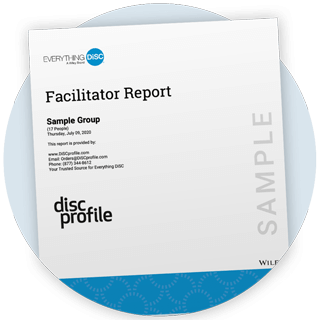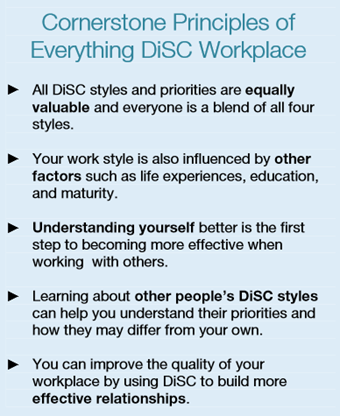Debriefing Everything DiSC® profiles
People new to Everything DiSC® may wonder about how to discuss the assessment in a group or coaching session. We hope these tips will give you the confidence to work with Everything DiSC assessments. These notes aren’t a substitute for the facilitation kits available for each assessment.
Preparation before the assessment
Preparation before your session or workshop
Preparation before the assessment
People will have questions about why they are being asked to take a personality assessment and how it will be used.
Let participants know why you or your organization decided to offer this opportunity. Is it for professional development? To increase employee engagement? To reduce conflicts between departments? To improve workplace communication?
Let participants know how you’ll use the profile results. Will they be shared with others? Some organizations ask employees to post their Everything DiSC Workplace Style Guides outside their offices, or share their DiSC style in their internal email signatures.
Some participants will be concerned about the validity of the instrument. Be ready with a simple answer and more details if requested. You might want to review Science behind DiSC or purchase the Everything DiSC Manual for reference.
Preparation before your session or workshop
Before meeting with participants, review your learning objectives. What’s essential for learners to walk away with? What points must be covered? What work could learners do independently before, between, or as follow-up to your session?
What support materials do you need? Will you need to embed video in a presentation? Will you be providing handouts or assigning homework?
Will you be debriefing a group or an individual?
Debriefing with a group
Goals and logistics
A training session should always begin with introductions and logistics. Even participants on a video call can introduce themselves briefly, perhaps by placing their DiSC dot on a shared whiteboard showing the Everything DiSC circle. Logistics should cover where to find things in the physical or virtual world, and what your expectations are for appropriate participation.
Review why this group was asked to take the assessment and ask for any goals they might have.
Cornerstone principles and concepts
Early in your session, go over the cornerstone principles found on page 2 of most Everything DiSC profiles and allow for questions regarding them. You might start with an activity like Discovering Your DiSC Style (explained in most facilitation kits) or a video (also included in kits) to introduce general DiSC concepts. Be sure to cover the four major styles, the priorities of each style, and explain how dot placement – both distance to the edge of the circle and proximity to another style – further define a participant’s style. See DiSC® dot and priorities explained.
Personal reflections/interaction with profile
Everyone is a little egocentric and will welcome time spent focused on their own reports. Ask learners to interact with their report and highlight or circle what really fits them and cross out or otherwise mark descriptions that don’t fit as well. Learners can share the statements they like most with others in the group. If there are participants with four or even five priorities, help them and the group understand what additional priorities are and that having extra priorities is neither better nor worse than having three.
Activities
Groups will benefit from time spent interacting with each other, sharing their own insights and questions. Several activities are found in the facilitation kits. You’ll also find more at DiSC activities.
Team styles
If participants are all part of the same team, you will want to discuss how the group also has a personality. Ask about how that group style influences team member behavior and how the team works with other groups and leaders. What strengths and weaknesses do they think are true of their team?
If participants are from different teams, ask them about how well they think each of the four styles are represented in their teams. Is there a style missing? How can people flex into that style to make the team work more effectively?

Facilitator Report
Many facilitators find that having the Everything DiSC Facilitator Report ahead of time helps them prepare for the session. This report provides the names of participants, how they scored on the assessment, and the balance of the team based on styles. It also suggests issues to consider regarding the group’s culture.
MyEverythingDiSC or Catalyst
If you’re using either of these platforms, be sure to demonstrate how they can be used to compare styles with others and to learn more about DiSC.
Sum it up/action plans
Review the goals for your session. Ask about what people have learned and how they will apply this new knowledge. Assign action plans or worksheets provided in the profile, in your facilitation kit, or that you’ve created. Let them know that you’re available for continued work using Everything DiSC and building on what they’ve learned today.
Thank everyone for their participation. If participants want to share their experience on social media, suggest they use the hashtag #Everythingdisc.
Debriefing with an individual
Working with just one person gives you the ability to completely read their report and prepare for communicating with them based on their style. You can also prepare questions that directly relate to what you know of the learner’s work environment.
Review purpose
If the assessment is part of onboarding, to help with communication, to increase self-awareness, or another reason, set the stage for focusing your conversation.
Cornerstone principles
Before getting into the meat of the report, be sure to cover the cornerstone principles and general concepts of DiSC. This helps to put the profile report into a broader context.
Personal reflections
Allow the learner time to review the first page or two about themselves. Ask about how well they think it applies to them. Are there surprises? Anything they don’t like learning? Anything they feel particularly good about? How can they use this information to improve their work relationships, communication, or leadership? What parts of the report would they like to share with their manager or colleagues?
Reflections on other styles
Everything DiSC focuses not just on the individual but on relationships. Be sure to discuss how to work better with others. If you know the styles of the team your learner is on or of their supervisor, direct the conversation to examples of working with those particular styles.
Supplemental Report
You can go even deeper into the assessment by using the Everything DiSC Supplement for Facilitators. You’ll be able to see more specific, detailed data about the person’s DiSC style and dot placement, which priorities they rank highly for, and items in the questionnaire that were answered in a way unexpected for someone with their style. We recommend using this report if your learner disagrees with their style or their dot is placed close to the center.
Comparison Report
You can review Everything DiSC Comparison Reports. These can be very useful if the learner is experiencing conflict with another person in the organization or getting a new boss, direct report, or team member.
What’s next?
What will each of you take away from your discussion? What next steps do you want to take together? Will you assign any follow-up work?
--
Listen to a quick example debriefing: DiSC Assessment: Rob Finds Out His Behavioral Style, a podcast episode
Notes on profile applications
Workplace: Debriefing can include discussions around motivation and stress, communicating better with other styles, or resolving conflicts with other styles. With individuals, you can spend time on page 16, “Taking Action.”
Agile EQ: Workplaces are emotionally charged. This profile recognizes this fact and helps people understand how their own natural tendencies influence their interpersonal interactions. After allowing time to review and reflect on one’s own mindsets, move on to pages 15 - 26. Pick only one or two mindsets to work on. Select a beginner, intermediate, or advanced action to follow. Plan when and how to revisit these pages to keep accountable for taking action.
Productive Conflict: Personal reactions to conflict and the destructive and productive conflict behaviors of each DiSC style are examined in this report. Use with individuals or teams to improve communication strategies when engaging in productive conflict with colleagues. On page 20, you can go over reframing the learner’s knee-jerk thoughts in the section “Changing Your Response.”
Management: Management issues such as directing and delegating work and motivating and developing others are easily covered using this profile. You can also cover how to work with one’s own manager. When coaching you can focus on specific DiSC styles the learner is challenged by or priorities they need to strengthen.
Sales: The Everything DiSC Sales profile is focused on sales, but we’re all in sales even if it’s not in our title. We all want to influence others and we want to understand the interest of others, too. With groups you can focus on understanding the interests and priorities of the four DiSC styles and how to meet those expectations. You can explain how to create a customer interaction map. With individuals you might want to create a customer interaction map for one of their target customers before you begin your debriefing. You can use it to frame and focus your conversation. You can go through page 23 of the Sales report to develop an action plan together.
Work of Leaders: This profile requires that you spend time on the Vision, Alignment, and Execution concepts that are central to the assessment and report. Each step should be delivered sequentially, but extra time can be spent wherever there seems to be the greatest need. Coaches can focus on pages 21 -23, “Your Leadership Challenges.”
Everything DiSC profiles are designed to work with any organization and within multiple training and coaching situations. The facilitation materials offered in the facilitation kits are customizable to your own and your learners’ needs. Here we’ve covered only the basics.


